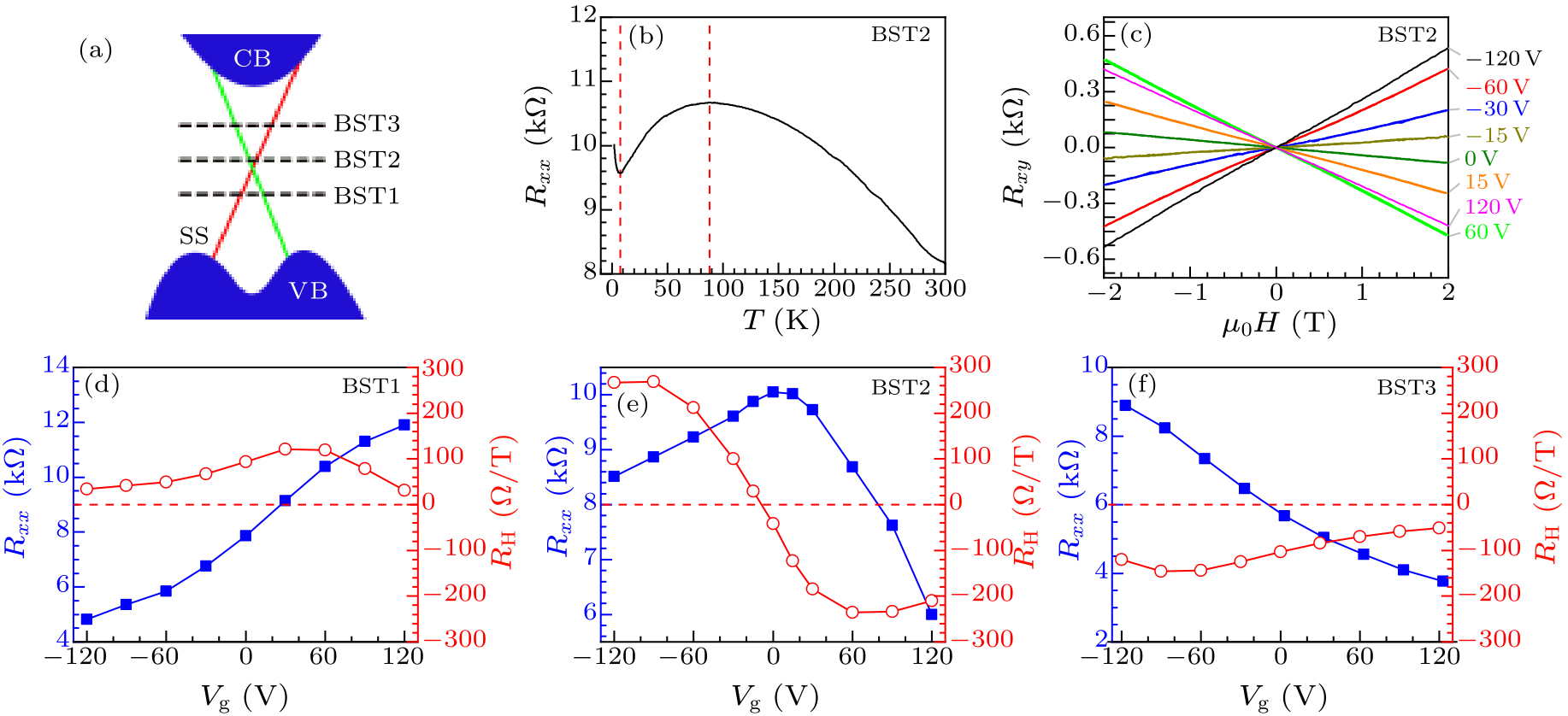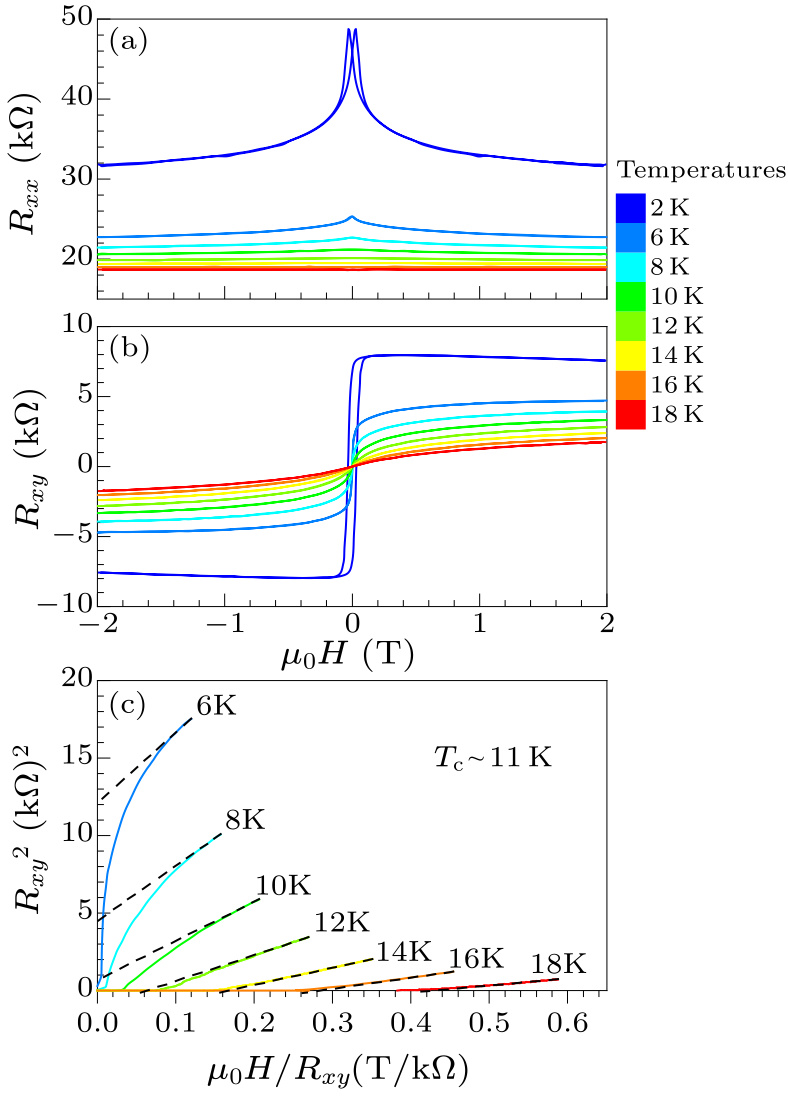
Fig. 1. Structural characterization of Bi$_{2}$Te$_{3}$ and BST thin films grown on amorphous SiO$_{2}$/Si by magnetron sputtering. (a) Photograph of a Bi$_{2}$Te$_{3}$/SiO$_{2}$ film with a diameter of 10 cm. (b) Electronic band structure of a Bi$_{2}$Te$_{3}$ thin film measured by ARPES showing linear dispersion of topological surface states (red dashed line). (c) HRTEM image and (d) XRD pattern of a BST thin film grown on amorphous SiO$_{2}$ (sample BST2). (e) The rhombohedral crystal structures of Bi$_{2}$Te$_{3}$ and (Bi$_{1-x}$Sb$_{x})_{2}$Te$_{3}$.

Fig. 2. Electrical transport in 7 nm thick BST thin films. (a) Schematic band structure for samples BST1, BST2 and BST3 and the corresponding Fermi levels, where CB, VB and SS are the bulk conduction band, bulk valance band and surface state, respectively. (b) The temperature ($T$) dependence of the longitudinal sheet resistance ($R_{xx}$) at zero magnetic field. From left to right, two red dashed lines are located at $T=7$ K and $T=88$ K, respectively. (c) Hall resistance $R_{xy}$ as a function of magnetic field $\mu_{0}H$ at 2 K tuned by the back-gate voltage. (d)–(f) Dependence of zero field longitudinal sheet resistance $R_{xx}$(0) (solid squares) and Hall coefficient $R_{\rm H}$ (open circles) on the back-gate voltage for samples BST1 (d), BST2 (e) and BST3 (f) at $T=2$ K.
| Device | $R_{xx}$ (k$\Omega$) | $T$ (K) | Thickness | |
|---|---|---|---|---|
| CVD-grown BST | 0.5–5.5 | 2 | 5 nm | Ref. |
| MBE-grown BST | 8–12 | 2.2 | 20 nm | Ref. |
| 3–12 | 0.04 | 8 nm | Ref. |
|
| 2–6 | 2.1 | 7 nm | Ref. |
|
| 2–8 | 1.6 | 8 nm | Ref. |
|
| 1–3 | 1.6 | 20 nm | Ref. |
|
| 2–12 | 1.4 | 10 nm | Ref. |
|
| 3–12 | 6.9 | 10 nm | Ref. |
|
| Sputter-deposited BST | 6–10 | 2 | 7 nm | This work |

Fig. 3. Ferromagnetic characterization of a 6 nm thick CBST thin film. (a) Longitudinal resistance $R_{xx}$ and (b) Hall resistance $R_{xy}$ vs $\mu_{0}H$ at different temperatures. (c) Arrott plot of the CBST thin film.

Fig. 4. (a) Longitudinal sheet resistance $R_{xx}$ and (b) Hall resistance $R_{xy}$ vs $\mu_{0}H$ at different gate voltages at a temperature of 2 K. (c) $V_{\rm g}$-dependent $R_{\rm AH}$ (open circles) and $R_{xx}$(0) (solid squares) measured at 2 K.
| [1] | Hasan M Z and Kane C L 2010 Rev. Mod. Phys. 82 3045 | Colloquium : Topological insulators
| [2] | Qi X L and Zhang S C 2010 Phys. Today 63 33 | The quantum spin Hall effect and topological insulators
| [3] | Fan Y B et al 2014 Nat. Mater. 13 699 | Magnetization switching through giant spin–orbit torque in a magnetically doped topological insulator heterostructure
| [4] | Fan Y B et al 2016 Nat. Nanotechnol. 11 352 | Electric-field control of spin–orbit torque in a magnetically doped topological insulator
| [5] | Yasuda K et al 2017 Phys. Rev. Lett. 119 137204 | Current-Nonlinear Hall Effect and Spin-Orbit Torque Magnetization Switching in a Magnetic Topological Insulator
| [6] | Han J H et al 2017 Phys. Rev. Lett. 119 077702 | Room-Temperature Spin-Orbit Torque Switching Induced by a Topological Insulator
| [7] | Dc M et al 2018 Nat. Mater. 17 800 | Room-temperature high spin–orbit torque due to quantum confinement in sputtered BixSe(1–x) films
| [8] | He Q L et al 2018 Phys. Rev. Lett. 121 096802 | Topological Transitions Induced by Antiferromagnetism in a Thin-Film Topological Insulator
| [9] | Wang Y et al 2017 Nat. Commun. 8 1364 | Room temperature magnetization switching in topological insulator-ferromagnet heterostructures by spin-orbit torques
| [10] | He Q L et al 2017 Nat. Mater. 16 94 | Tailoring exchange couplings in magnetic topological-insulator/antiferromagnet heterostructures
| [11] | Mogi M et al 2017 Nat. Mater. 16 516 | A magnetic heterostructure of topological insulators as a candidate for an axion insulator
| [12] | Šmejkal L et al 2018 Nat. Phys. 14 242 | Topological antiferromagnetic spintronics
| [13] | Chen Y L et al 2009 Science 325 178 | Experimental Realization of a Three-Dimensional Topological Insulator, Bi2Te3
| [14] | Xia Y et al 2009 Nat. Phys. 5 398 | Observation of a large-gap topological-insulator class with a single Dirac cone on the surface
| [15] | Checkelsky J G et al 2011 Phys. Rev. Lett. 106 196801 | Bulk Band Gap and Surface State Conduction Observed in Voltage-Tuned Crystals of the Topological Insulator
| [16] | Peng H et al 2010 Nat. Mater. 9 225 | Aharonov–Bohm interference in topological insulator nanoribbons
| [17] | Wang Z H, Yang L, Li X J, Zhao X T, Wang H L, Zhang Z D and Gao X P 2014 Nano Lett. 14 6510 | Granularity Controlled Nonsaturating Linear Magnetoresistance in Topological Insulator Bi 2 Te 3 Films
| [18] | Chen X, Ma X C, He K, Jia J F and Xue Q K 2011 Adv. Mater. 23 1162 | Molecular Beam Epitaxial Growth of Topological Insulators
| [19] | Taskin A A, Sasaki S, Segawa K and Ando Y 2012 Adv. Mater. 24 5581 | Achieving Surface Quantum Oscillations in Topological Insulator Thin Films of Bi 2 Se 3
| [20] | Chang C Z, Zhang J S, Feng X, Shen J, Zhang Z C, Guo M H, Li K, Ou Y B, Wei P, Wang L L, Ji Z Q, Feng Y, Ji S H, Chen X, Jia J F, Dai X, Fang Z, Zhang S C, He K, Wang Y Y, Lu L, Ma X C and Xue Q K 2013 Science 340 167 | Experimental Observation of the Quantum Anomalous Hall Effect in a Magnetic Topological Insulator
| [21] | Wang W J, Gao K H and Li Z Q 2016 Sci. Rep. 6 25291 | Thickness-dependent transport channels in topological insulator Bi2Se3 thin films grown by magnetron sputtering
| [22] | Sapkota Y R and Mazumdar D 2018 J. Appl. Phys. 124 105306 | Bulk transport properties of bismuth selenide thin films grown by magnetron sputtering approaching the two-dimensional limit
| [23] | Wang J, DaSilva A M, Chang C Z, He K, Jain J K, Samarth N, Ma X C, Xue Q K and Chan M H W 2011 Phys. Rev. B 83 245438 | Evidence for electron-electron interaction in topological insulator thin films
| [24] | He X Y, Guan T, Wang X X, Feng B J, Cheng P, Chen L, Li Y Q and Wu K H 2012 Appl. Phys. Lett. 101 123111 | Highly tunable electron transport in epitaxial topological insulator (Bi 1- x Sb x ) 2 Te 3 thin films
| [25] | Checkelsky J G, Yoshimi R, Tsukazaki A, Takahashi K S and Tokura Y 2014 Nat. Phys. 10 731 | Trajectory of the anomalous Hall effect towards the quantized state in a ferromagnetic topological insulator
| [26] | Kong D S, Chen Y L, Cha J J, Zhang Q F, Analytis J G, Lai K J, Liu Z K, Hong S S, Koski K J and Mo S K 2011 Nat. Nanotechnol. 6 705 | Ambipolar field effect in the ternary topological insulator (BixSb1–x)2Te3 by composition tuning
| [27] | Shimizu S, Yoshimi R, Hatano T, Takahashi K S, Tsukazaki A, Kawasaki M, Iwasa Y and Tokura Y 2012 Phys. Rev. B 86 045319 | Gate control of surface transport in MBE-grown topological insulator (Bi Sb ) Te thin films
| [28] | Yoshimi R, Tsukazaki A, Kozuka Y, Falson J, Takahashi K S, Checkelsky J G, Nagaosa N, Kawasaki M and Tokura Y 2015 Nat. Commun. 6 6627 | Quantum Hall effect on top and bottom surface states of topological insulator (Bi1−xSbx)2Te3 films
| [29] | Lee J S, Richardella A, Hickey D R, Mkhoyan K A and Samarth N 2015 Phys. Rev. B 92 155312 | Mapping the chemical potential dependence of current-induced spin polarization in a topological insulator
| [30] | Tian J F, Chang C Z, Cao H L, He K, Ma X C, Xue Q K and Chen Y P 2015 Sci. Rep. 4 4859 | Quantum and Classical Magnetoresistance in Ambipolar Topological Insulator Transistors with Gate-tunable Bulk and Surface Conduction
| [31] | Islam S, Bhattacharyya S, Kandala A, Richardella A, Samarth N and Ghosh A 2017 Appl. Phys. Lett. 111 062107 | Bulk-impurity induced noise in large-area epitaxial thin films of topological insulators
| [32] | Cha J J, Williams J R, Kong D, Meister S, Peng H, Bestwick A J, Gallagher P, Goldhaber G D and Cui Y 2010 Nano Lett. 10 1076 | Magnetic Doping and Kondo Effect in Bi 2 Se 3 Nanoribbons
| [33] | Hor Y S, Roushan P, Beidenkopf H, Seo J, Qu D, Checkelsky J G, Wray L A, Hsieh D, Xia Y, Xu S Y, Qian D, Hasan M Z, Ong N P, Yazdani A and Cava R J 2010 Phys. Rev. B 81 195203 | Development of ferromagnetism in the doped topological insulator
| [34] | Checkelsky J G, Ye J T, Onose Y, Iwasa Y and Tokura Y 2012 Nat. Phys. 8 729 | Dirac-fermion-mediated ferromagnetism in a topological insulator
| [35] | Li H, Song Y R, Yao M Y, Yang F, Miao L, Zhu F F, Liu C H, Gao C L, Qian D, Yao X, Jia J F, Shi Y J and Wu D 2012 Appl. Phys. Lett. 101 072406 | Carriers dependence of the magnetic properties in magnetic topological insulator Sb1.95−xBixCr0.05Te3
| [36] | Li B, Fan Q Y, Ji F H, Liu Z, Pan H and Qiao S 2013 Phys. Lett. A 377 1925 | Carrier dependent ferromagnetism in chromium doped topological insulator
| [37] | Chang C Z, Zhang J S, Liu M H, Zhang Z C, Feng X, Li K, Wang L L, Chen X, Dai X and Fang Z 2013 Adv. Mater. 25 1065 | Thin Films of Magnetically Doped Topological Insulator with Carrier-Independent Long-Range Ferromagnetic Order
| [38] | Nagaosa N, Sinova J, Onoda S, MacDonald A H and Ong N P 2010 Rev. Mod. Phys. 82 1539 | Anomalous Hall effect
| [39] | Kou X F, Lang M R, Fan Y B, Jiang Y, Nie T X, Zhang J M, Jiang W J, Wang Y, Yao Y G, He L and Wang K L 2013 ACS Nano 7 9205 | Interplay between Different Magnetisms in Cr-Doped Topological Insulators
| [40] | Chang C Z, Zhao W, Kim D Y, Zhang H J, Assaf B A, Heiman D, Zhang S C, Liu C X, Chan M H W and Moodera J S 2015 Nat. Mater. 14 473 | High-precision realization of robust quantum anomalous Hall state in a hard ferromagnetic topological insulator
| [41] | Kandala A, Richardella A, Kempinger S, Liu C X and Samarth N 2015 Nat. Commun. 6 7434 | Giant anisotropic magnetoresistance in a quantum anomalous Hall insulator